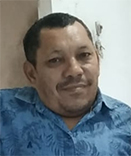The Workshop on Renewable Energy Sources and Nanotechnology
Wren 2019
SEMINARS
FIRST DAY - Dec 09, 2019

SEMINAR 01
Christiane de Arruda Rodrigues
- NEW ADVANCES ON PHOTONANOCATALYSTS FOR RENEWABLE ENERGY.
ABSTRACT: TCarbon dioxide (CO2) is the main responsible for greenhouse effect. The global concentration of CO2in the atmosphereis increasing mainly due to the emissions from fossil fuel combustion. The reduction of CO2by photocatalysis is one of the most promising methods since CO2can be reduced to useful compounds by irradiating it with UV light at room temperature and ambientpressure. Several semiconductors, titled p-type, exhibit suitable band energies for photocatalytic reduction of carbon dioxide. Among various catalysts, copper oxides have properties that leads methanol and . Ler mais . . .

SEMINAR 02
Juliano Alves Bonacin
- EARTH-ABUNDANT TRANSITION METAL CATALYSTS FOR WATER OXIDATION UNDER MILD CONDITIONS.
ABSTRACT: The development of an alternative to fossil fuels isone of the big challenges of our society. There is an estimate that global energy consumption in the next 35 years will be almost double the current. Because of this, the expansion of the energy matrix using fossil-based fuels can lead to the collapse of the planet. Based on this scenario, it is indispensable to study alternative sources of energy to meet this demand. Many strategies for using renewable energy sources have been inspired by the natural photosynthetic system, where water can be used as a source of energy through the production of hydrogen and oxygen1,2. Ler mais . . .

SEMINAR 03
Marcos Allan Leite dos Reis
- ARC WELDING OF NI-CNTS@316L NANOCOMPOSITE FOR INDUSTRIAL APPLICATIONS.
ABSTRACT: N recent years someprogress has been made about incorporation of Carbon Nanotubes –CNTs in metal matrix by arc welding.Despite that, there is scarce information relating tomicrostructural modifications induced by nanomaterial inthe welding metal.In this sense,we present the incorporation of nanocomposite based on Nickel/Carbon Nanotubes@stainless steel 316Lalloy–Ni-CNTs@316L via Gas Tungsten Arc Welding Pulsed –GTAW-P in the surface of a metal matrix based on manganesesteel namely as base metal. Themanufacturedspecimens with/without nanocomposite were characterized by: optical . Ler mais . . .

SEMINAR 04
Mozaniel S. de Oliveira
- GREEN SOLVENTS, THE USE OF SUPERCRITICAL CO2 TO OBTAIN HIGH ADDED VALUE SECONDARY METABOLITES.
ABSTRACT: Extraction with supercritical fluid is the combination of a set of unit operations, this extraction technique may represent an alternative to conventional methods, since it does not use organic solvents during the separation process, in the literature it is known as green extraction, and Depending on the parameters used during the extraction we may have a selectivity in the separation of high added value bioactive compounds, natural substances may represent a viable alternative in the search for new medicines and have various industrial applications such as in the food, cosmetic and pharmaceutical industries. Extraction with . Ler mais . . .

SEMINAR 05
Jordan Del Nero
- MOLECULAR ELECTRONICS THROUGH TUNNELING IN 1D AND QUASI-1D DEVICES.
ABSTRACT: We have simulated electron tunneling through one-dimensional molecular junctions based on first-principles simulations using the density functional theory combined with the non-equilibrium Green's functions methodology.The bridging atom bonds weakly to the electrodes in both systems, it strongly affects the electronic transport properties, such as electron transmission, current–voltage relation, differential conductance, density of states and eigenchannels. This is demonstrated by comparing with the results obtained from the corresponding systems for both the 1D and the quasi-1D junctions in the absence of the central sodium atom. The revealed transport properties are sensitive to the molecular . Ler mais . . .

SEMINAR 06
Marcelo ricardo souza siqueira
- MOLECULAR ELECTRONICS OF BIOLOGICAL COMPOUNDS.
ABSTRACT: Molecular electronics is a interdisciplinary field of study that combines several techniques to find applications of molecules as components of integrated circuits and try miniaturize electronic devices. His benefits are the low consume of energy, flexibility, low size, etc. The analysis of molecules that are in biological compounds provides other point of view to understand how the dynamic electronic configuration in these systems influences the biological processes in plants and animals. All living mater is a complex electronic device. The simplest understanding about molecular electronics in biological compo . Ler mais . . .
SECOND DAY - Dec 10, 2019

SEMINAR 07
Járlesson G. Amazonas
- PROPOSALS FOR DECENTRALIZED RENEWABLE ENERGY SOURCES DEVELOPED AT UNIVERSITY OF THE STATE OF PARÁ.
ABSTRACT: Energy is an essential asset to leverage the economic and social development of a country. In Brazil, hydroelectric power stations produce most of the electricity, but also generate numerous social and environmental impacts, high construction and distribution costs. Besides, there is a strong dependence on rainfall indices to maintain reservoir levels and river flow, showing that the national energy matrix needs to be expanded and better planned through diversification of its sources. Thus, it is evident the need for new proposals of alternative and decentralized energy sources, which electricity is generated near the consumer centers, facilitating the management, minimizing . Ler mais . . .

SEMINAR 08
Jose Francisco Da Silva Costa
- SOLAR OVEN AS AN ALTERNATIVE WATER DISINFECTION RESOURCE.
ABSTRACT: The present work seeks to use the solar oven as an alternative water disinfection resource and to show the application, the procedures are performed from 1000 mL polyethylene bottles containing water from the Maratauíra River belonging to the municipality of Abaetetuba-Pa. The samples were taken to the disciplinary laboratory of the Basílio de Carvalho School where the prototype of the solar oven was assembled telling the partnership of the local Science Club. In a specific area surrounding the school, the temperature and pH of the samples were measured at time intervals of one hou . Ler mais . . .
THIRD DAY - Dec 11, 2019





Wren 2019. © All Right Reserved
Laboratory for Preparation and Computation of Nanomaterials - (LPCN)
